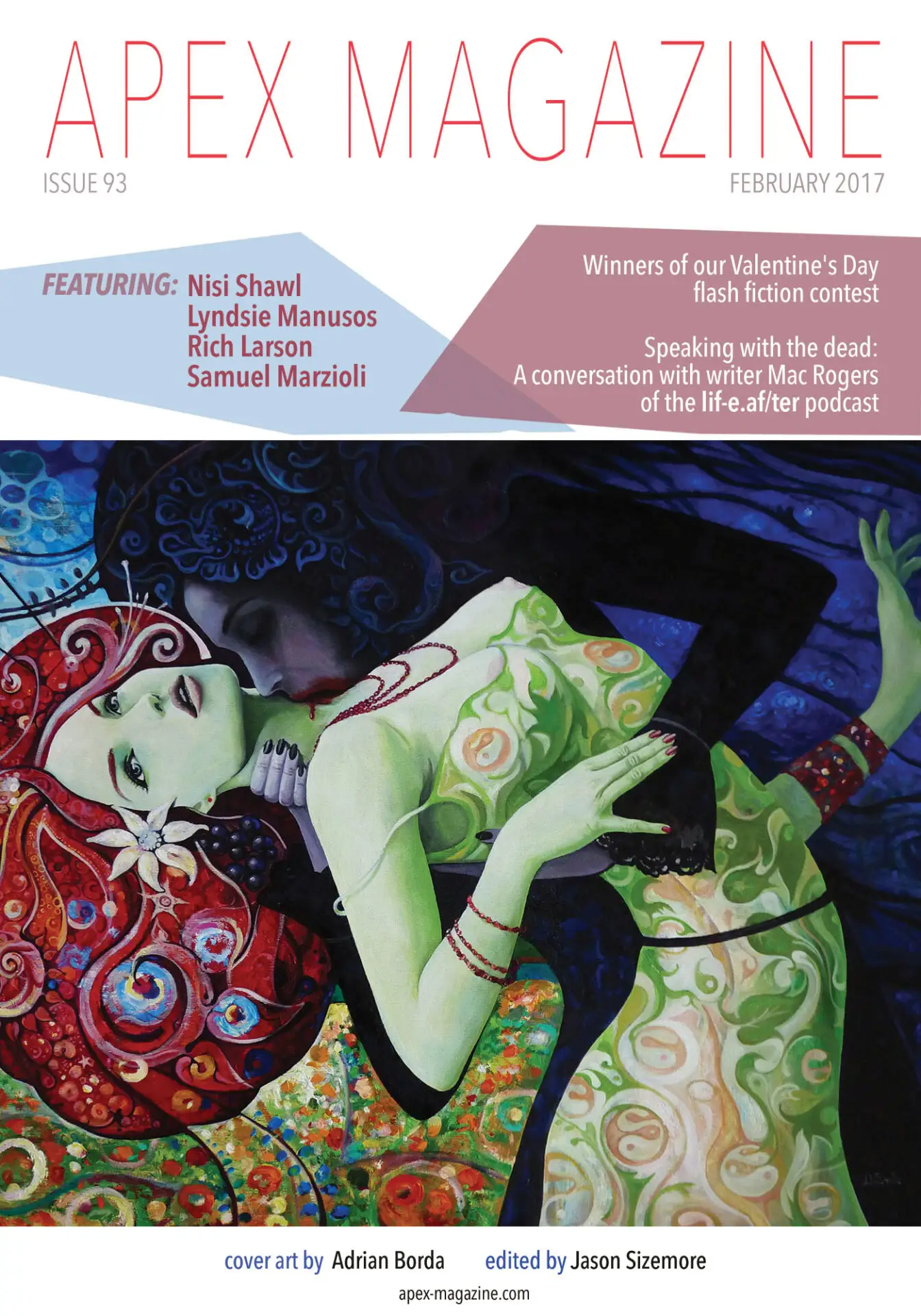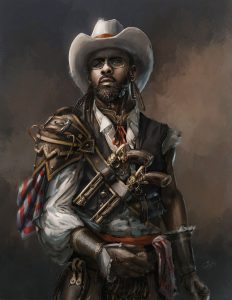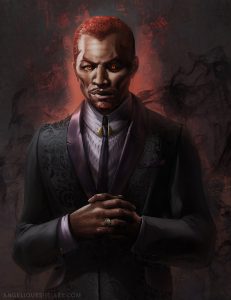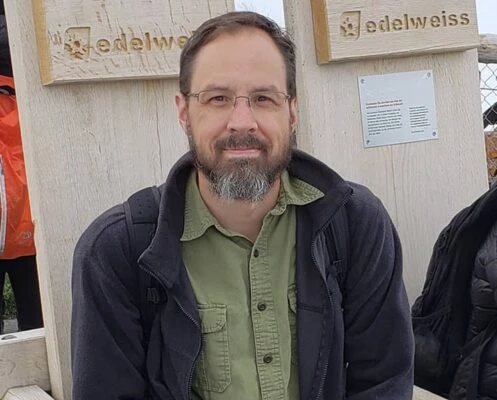
The beautiful and atmospheric cover art for our April issue was created by Angelique Shelley, a concept artist and illustrator currently residing in London. Shelley’s work explores different cultures in unique ways, and her cover piece, “Xeno-Africa,” shows the strong influence of a childhood spent in South Africa.
APEX MAGAZINE: In the description of your piece for this month’s Apex Magazine cover, “Xeno-Africa,” you describe the piece as being influenced by the traditional art and culture of Africa. When you are combining real places and cultures with fantasy and science fiction, where in the process does fantasy take over from reality? Does that evolve as you go, or do you have a fairly solid plan at the beginning?
ANGELIQUE SHELLEY: I find the best fantasy has a foundation in reality–it contains an element of something that the viewer can recognize or has experience of, and then pushes that in unexpected ways and introduces new, unfamiliar ideas into the mix. Using “Xeno-Africa” as an example, from the start I wanted it to answer the question: “On an alien world, what would a futuristic Africa look like?” I had this idea that they would live in giant anthills and that they would travel the air as if it were the ocean. So the idea of fish-shaped airships was born. These are ideas that were inspired by real things.
I wanted their tech to remain very organic and to be combined with nature; this relationship was very important for me to convey. Then came a mountain of research. So, in answer to your question: sometimes art takes you on a journey, but most of the time, when creating pieces like this one, a lot of careful planning is undertaken, the initial idea evolving the more research you do. A lot of the time, you’ll come across something really awesome, and the fun bit is twisting it to fit into your fantastical world.
AM: “Xeno-Africa” is described on your website as being a part of a world building project, and that you wanted to infuse as much African culture as possible. Are there particular African cultures that influence you more than others? How do other projects and pre-existing worlds, like the Tolkien/Lord of the Rings worlds, affect a project like “Xeno-Africa?”
AS: I like my work to be influenced by many African cultures, particularly the ones that hold visual intrigue. At the moment, my concepts don’t have as many cultural ties as I would hope for, I would love to include more aspects of the previously mentioned relationship with nature, or hierarchy/social elevations, lore, and superstitions, even if it’s on a subliminal basis. Other well-loved and flawless worlds, such as Tolkien’s Middle Earth, are certainly a benchmark and can help you create a check-list for building a new world if you study what makes them successful. However, I think world building, such as in my piece, can also become a natural process. For example, I set certain parameters, challenges, and limitations and then thought about how a civilization (in this instance one inspired by the many tribes of Africa) may adapt to it with their current knowledge, available materials, and tools, and even taking into account basic needs and desires, as well as luxuries or excessiveness. This may seem like a lot, but having a solid foundation can shine through in your work in the little details as well as the large, resulting in a richer, more believable world.
AM: Your website features a strong sense of multicultural art, and you mention on your site that you spent much of your childhood in South Africa. How important is it, especially in the volatile environment of today’s world, to create art featuring varied cultures? Is it something you find lacking in media, or have there been good strides to be more inclusive?
AS: The industry is beginning to become more multicultural, in both its art and the artists behind it. With the internet, more and more artists are able to share their work with the rest of the world, as a result, leading companies are able to talent spot these individuals and offer them a place at their establishment, or they can apply themselves.
I know a lot of western artists that first started their journey by copying the manga style from Japan, which is wonderful as it inspired them to make art, but I would suggest to every new artist that they remain true to their roots. This first came to me over dinner when I was brooding over the awesome designs of Feng Zhu, I really wanted to emulate his work, including the East Asian influence to his concepts. But then it occurred to me that Feng Zhu has lived and experienced that culture, and I haven’t. The natural flow of thought was to then question what I had experienced in South Africa and to use that personal knowledge and create something true to me. As a result, most of my clients were first drawn to me because of the work that resulted from this epiphany.
However, I don’t profess to be an expert in African cultures, when I create new work influenced by them, I still do my research thoroughly. Though, it’s good to note here that being diverse in both style and influence is important if you want to work in the media industry, but doing something new and unique (like you) is what sets you apart from the mainstream community.
AM: You have beautiful galleries on a few services, including DeviantArt and CG Society, as well as social media accounts. Does having art on different services help to capture different audiences? Are you hoping to cast a net for a specific audience, such as art directors or clients, is it more to gain a larger following of art enthusiasts, or a combination?
AS: Online art communities are a great blessing and a superb way to get yourself noticed, as well as help you to set new goals for your own self-improvement. It keeps you humble and inspired. It’s also really motivating when people start taking an interest in your art. And getting involved in the art community through critique can help you recognize problems with your own art. These communities are perfect for attracting both art enthusiasts and clients. A lot of my clients find me through DeviantArt, and a lot of larger companies use ArtStation as their go-to platform for finding new talent or posting available positions in their amazing job section. It was through ArtStation that I was contacted to do a spot of work for Universal. So my suggestion is to join them all and get involved, you literally have nothing to lose, though if you’re worried about art thieves, you should probably watermark your work.
AM: One of the pages on your website is a “Terms and Conditions” page, which is something that, after years of working with clients, I added to my own site. How often do you need to refer someone to those terms, and what is the value of having that type of communication up front? If you met an up-and-coming artist, what are the important ideas they need to know before working on professional projects?
AS: I send a copy of my T&C’s early on, usually with my quote so they don’t develop any unhealthy expectations. I think being clear from the start is the best way to work as it will probably legally negate any future problems once they formally agree to it. I’ve been fortunate that I haven’t had any clients that have refused to pay at the completion of a project, but I would suggest to new-comers that they ask for a 50% deposit up front and heavily watermark all work they send to them and only send the clean copies once the client has paid the remainder of the fee. If things still go wrong, you have that handy T&C to fall back on, and as long as you’ve upheld your end, such as the work being the agreed quality, then you’ll be able to take legal action if you wish. It’s also a good idea to have a print-release form for the client depending on what they commissioned the work for. Last, but not least, remember to make sure that the software you are using allows you to sell the artwork you create with it.
AM: Thank you to Angelique Shelley for her in-depth insight into her world of art. You can see more of her artwork in her online gallery at DeviantArt or on her website at www.angeliqueshelley.com.












